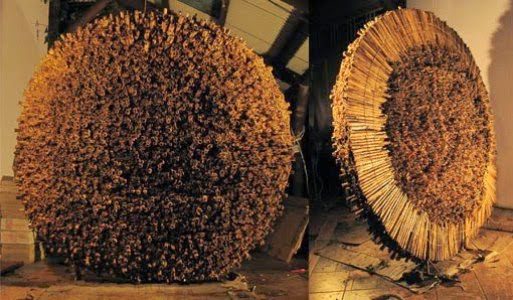Gitanjali presented her research at the Stuart Hall Library Research Network meeting on 15 May 2014. She has kindly written about her research in more detail, for those of you who missed the event.

Sculpture by Nirmal Hurry, courtesy of the artist
Constructing a cultural memoriography
My research takes Nirmal Hurry’s later works as entry point to an engagement with art and memory where remembering events like Slavery and Indenture become an aesthetic exercise. Political art constitutes a category of memory that becomes at the same time an aesthetic category. Cultural scholar Jill Bennett calls it affective memory or sense memory. Sense memory operates through the body to produce a kind of ‘seeing truth’ rather than ‘thinking truth’, registering the pain of memory as it is directly experienced and communicating a level of bodily affect. I make a comparison with state historiographies which make us think truth, while art constitutes seeing and feeling truth. The art of sense memory might further be distinguished as a motivated practice where engaging in practical aesthetics gives rise to a conception of aesthetics inspired by real-world encounters.
What is memoriography?
‘a body of professional historical writings which deals with the way in which events are recalled and understood in the present’ (Carrier 2014). While historians tend to discard diaries, witness accounts, art and music which operate on the periphery of the discipline, memoriography considers several aspect of historical events which are not the focus of grand narratives. The study of Memory is not an alternative to historiography, nor a complement to it, but an extension to the broader field of enquiry which denounces the nomological (principles that resemble laws) imposition of historiography. An understanding of contemporary works reveals the fluid states of objects, in the reflection of Bruno Latour, which allow a practical aesthetics to rise from the encounter with an event. Japanese artist Chino Otsuka entitled her exhibition, at the British Library, ‘Memoriography’ to depict her journey across time and locations. She photographs herself in the same places, that she visited and had been photographed when she was younger and superimposes the two pictures to have her childhood and adulthood intersect at a junction in memory. For her, memory is prospective, allowing her to bring the past forward in the present.
Nirmal Hurry
I met the sculptor, Hurry 10 years ago and have been fascinated by the memories infused into his political art. Hurry studied in France at L’Ecole des Beaux Arts and India at the Jamma Millia Islamia and is now an established visual artist in Mauritius. Many of Hurry,’s works, accompanied by satirical poetic pieces in vernacular creole, consist of a direct engagement with actual Mauritian politics. Many of his contemporary installations denounce a repressive state historiography and is transformed, in an affective way, into a ‘sensuous’ or ‘sensitive’ knowledge, as termed by Baumgarten. His works do not reproduce the world in a nomological documentative perspective, like History or the media for instance, but explore the nature of the event and its capacity to produce affect. I explore memory as an involving bodily responses that lie outside verbal-semantic-linguistic representations where the artwork evokes immediate affective experience. Last but not least my research will also attempt to understand the implication of languages on memories.
An audio recording of Gitanjali’s presentation is available below.